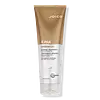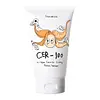What's inside
What's inside
 Key Ingredients
Key Ingredients

 Benefits
Benefits

 Concerns
Concerns

 Ingredients Side-by-side
Ingredients Side-by-side

Water
Skin ConditioningCetearyl Alcohol
EmollientGlycerin
HumectantBehentrimonium Chloride
PreservativeCetyl Esters
EmollientLanolin
EmollientHydrolyzed Keratin
HumectantCocodimonium Hydroxypropyl Hydrolyzed Keratin
Skin ConditioningLaurdimonium Hydroxypropyl Hydrolyzed Keratin
Skin ConditioningHydrolyzed Keratin Pg-Propylmethylsilanediol
Skin ConditioningHydrogenated Olive Oil
Skin ConditioningOlea Europaea Fruit Oil
MaskingOlea Europaea Oil Unsaponifiables
Skin ConditioningButyrospermum Parkii Butter
Skin ConditioningArginine Hcl
Skin ConditioningPhosphatidylcholine
EmulsifyingRosa Canina Fruit Oil
EmollientAleurites Moluccanus Seed Oil
Skin ConditioningHydrolyzed Wheat Protein
Skin ConditioningPsidium Guajava Fruit Extract
AstringentAloe Barbadensis Leaf Juice
Skin ConditioningOenothera Biennis Oil
EmollientTocopheryl Acetate
AntioxidantEthylhexylglycerin
Skin ConditioningSodium Hyaluronate
HumectantGlycolipids
Skin ConditioningAmodimethicone
Isopropyl Alcohol
SolventPanthenyl Hydroxypropyl Steardimonium Chloride
Ceteareth-20
CleansingCitric Acid
BufferingTetrasodium EDTA
Trideceth-12
EmulsifyingCetrimonium Chloride
AntimicrobialBenzophenone-4
UV AbsorberHydrolyzed Wheat Starch
Skin ConditioningThioctic Acid
AntioxidantButyl Methoxydibenzoylmethane
UV AbsorberAllantoin
Skin ConditioningSodium Ascorbyl Phosphate
AntioxidantSodium Hydroxide
BufferingPhenoxyethanol
PreservativeHexyl Cinnamal
PerfumingLimonene
PerfumingBenzyl Salicylate
PerfumingParfum
MaskingWater, Cetearyl Alcohol, Glycerin, Behentrimonium Chloride, Cetyl Esters, Lanolin, Hydrolyzed Keratin, Cocodimonium Hydroxypropyl Hydrolyzed Keratin, Laurdimonium Hydroxypropyl Hydrolyzed Keratin, Hydrolyzed Keratin Pg-Propylmethylsilanediol, Hydrogenated Olive Oil, Olea Europaea Fruit Oil, Olea Europaea Oil Unsaponifiables, Butyrospermum Parkii Butter, Arginine Hcl, Phosphatidylcholine, Rosa Canina Fruit Oil, Aleurites Moluccanus Seed Oil, Hydrolyzed Wheat Protein, Psidium Guajava Fruit Extract, Aloe Barbadensis Leaf Juice, Oenothera Biennis Oil, Tocopheryl Acetate, Ethylhexylglycerin, Sodium Hyaluronate, Glycolipids, Amodimethicone, Isopropyl Alcohol, Panthenyl Hydroxypropyl Steardimonium Chloride, Ceteareth-20, Citric Acid, Tetrasodium EDTA, Trideceth-12, Cetrimonium Chloride, Benzophenone-4, Hydrolyzed Wheat Starch, Thioctic Acid, Butyl Methoxydibenzoylmethane, Allantoin, Sodium Ascorbyl Phosphate, Sodium Hydroxide, Phenoxyethanol, Hexyl Cinnamal, Limonene, Benzyl Salicylate, Parfum
Water
Skin ConditioningCetearyl Alcohol
EmollientBehentrimonium Chloride
PreservativeGlycerin
HumectantAmodimethicone
Cyclopentasiloxane
EmollientCitric Acid
BufferingIsopropyl Alcohol
SolventCetrimonium Chloride
AntimicrobialSodium Benzoate
MaskingDimethicone
EmollientTrideceth-12
EmulsifyingPanthenol
Skin ConditioningParfum
MaskingTocopheryl Acetate
AntioxidantCaramel
Cosmetic ColorantButylene Glycol
HumectantCornus Officinalis Fruit Extract
Skin ConditioningRehmannia Glutinosa Root Extract
Skin ConditioningDioscorea Japonica Root Extract
Skin ConditioningAlisma Orientale Tuber Extract
Skin ConditioningPaeonia Suffruticosa Root Extract
Skin ProtectingPoria Cocos Sclerotium Extract
AstringentCeramide NP
Skin ConditioningAlcohol
AntimicrobialHydrolyzed Silk
HumectantHydrolyzed Collagen
EmollientGelatin
Hydrolyzed Keratin
HumectantAvena Sativa Kernel Extract
Abrasive1,2-Hexanediol
Skin ConditioningHydrolyzed Wheat Protein
Skin ConditioningHydrolyzed Corn Protein
Skin ConditioningHydrolyzed Soy Protein
HumectantPhenoxyethanol
PreservativeDaucus Carota Sativa Root Extract
Skin ConditioningBrassica Oleracea Italica Extract
AstringentApium Graveolens Extract
Skin ConditioningSodium Dehydroacetate
PreservativeBrassica Oleracea Capitata Juice
Skin ConditioningOryza Sativa Extract
AbsorbentBrassica Rapa Leaf Extract
Skin ConditioningEthylhexylglycerin
Skin ConditioningSolanum Lycopersicum Fruit
EmollientIllicium Verum Fruit Extract
PerfumingCaprylyl Glycol
EmollientWater, Cetearyl Alcohol, Behentrimonium Chloride, Glycerin, Amodimethicone, Cyclopentasiloxane, Citric Acid, Isopropyl Alcohol, Cetrimonium Chloride, Sodium Benzoate, Dimethicone, Trideceth-12, Panthenol, Parfum, Tocopheryl Acetate, Caramel, Butylene Glycol, Cornus Officinalis Fruit Extract, Rehmannia Glutinosa Root Extract, Dioscorea Japonica Root Extract, Alisma Orientale Tuber Extract, Paeonia Suffruticosa Root Extract, Poria Cocos Sclerotium Extract, Ceramide NP, Alcohol, Hydrolyzed Silk, Hydrolyzed Collagen, Gelatin, Hydrolyzed Keratin, Avena Sativa Kernel Extract, 1,2-Hexanediol, Hydrolyzed Wheat Protein, Hydrolyzed Corn Protein, Hydrolyzed Soy Protein, Phenoxyethanol, Daucus Carota Sativa Root Extract, Brassica Oleracea Italica Extract, Apium Graveolens Extract, Sodium Dehydroacetate, Brassica Oleracea Capitata Juice, Oryza Sativa Extract, Brassica Rapa Leaf Extract, Ethylhexylglycerin, Solanum Lycopersicum Fruit, Illicium Verum Fruit Extract, Caprylyl Glycol
 Reviews
Reviews

Ingredients Explained
These ingredients are found in both products.
Ingredients higher up in an ingredient list are typically present in a larger amount.
This water-soluble silicone is used for its hydrating and softening properties. It is used to add a silky feel to skincare products and has great benefits for haircare.
In haircare, this ingredient:
- Adds shine
- Protects color
- Offers thermal protection
- Boosts hair strength
- Does not build up as easily
This ingredient is a preservative and often used for it's anti-static properties. You'll most likely see this ingredient in hair conditioners.
It does not cause irritation or sensitization in leave-on products at 1-5%.
Cetearyl alcohol is a mixture of two fatty alcohols: cetyl alcohol and stearyl alcohol. It is mainly used as an emulsifier. Emulsifiers help prevent the separation of oils and products. Due to its composition, it can also be used to thicken a product or help create foam.
Cetearyl alcohol is an emollient. Emollients help soothe and hydrate the skin by trapping moisture.
Studies show Cetearyl alcohol is non-toxic and non-irritating. The FDA allows products labeled "alcohol-free" to have fatty alcohols.
This ingredient is usually derived from plant oils such as palm, vegetable, or coconut oils. There is debate on whether this ingredient will cause acne.
Due to the fatty acid base, this ingredient may not be Malassezia folliculitis safe.
Learn more about Cetearyl AlcoholThis ingredient is a preservative, antimicrobial, and emulsifier. It is often used in cosmetics for its ability to cleanse, condition, and reduce static.
Cetrimonium chloride is a quaternary ammonium salt, meaning it has a water-soluble structure.
Citric Acid is an alpha hydroxy acid (AHA) naturally found in citrus fruits like oranges, lemons, and limes.
Like other AHAs, citric acid can exfoliate skin by breaking down the bonds that hold dead skin cells together. This helps reveal smoother and brighter skin underneath.
However, this exfoliating effect only happens at high concentrations (20%) which can be hard to find in cosmetic products.
Due to this, citric acid is usually included in small amounts as a pH adjuster. This helps keep products slightly more acidic and compatible with skin's natural pH.
In skincare formulas, citric acid can:
While it can provide some skin benefits, research shows lactic acid and glycolic acid are generally more effective and less irritating exfoliants.
Most citric acid used in skincare today is made by fermenting sugars (usually from molasses). This synthetic version is identical to the natural citrus form but easier to stabilize and use in formulations.
Read more about some other popular AHA's here:
Learn more about Citric AcidEthylhexylglycerin (we can't pronounce this either) is commonly used as a preservative and skin softener. It is derived from glyceryl.
You might see Ethylhexylglycerin often paired with other preservatives such as phenoxyethanol. Ethylhexylglycerin has been found to increase the effectiveness of these other preservatives.
Glycerin is already naturally found in your skin. It helps moisturize and protect your skin.
A study from 2016 found glycerin to be more effective as a humectant than AHAs and hyaluronic acid.
As a humectant, it helps the skin stay hydrated by pulling moisture to your skin. The low molecular weight of glycerin allows it to pull moisture into the deeper layers of your skin.
Hydrated skin improves your skin barrier; Your skin barrier helps protect against irritants and bacteria.
Glycerin has also been found to have antimicrobial and antiviral properties. Due to these properties, glycerin is often used in wound and burn treatments.
In cosmetics, glycerin is usually derived from plants such as soybean or palm. However, it can also be sourced from animals, such as tallow or animal fat.
This ingredient is organic, colorless, odorless, and non-toxic.
Glycerin is the name for this ingredient in American English. British English uses Glycerol/Glycerine.
Learn more about GlycerinHydrolyzed Keratin is derived from keratin. Keratin is a large protein that is naturally found in our hair and skin.
Studies show keratin is able to seal broken hair cuticles, helping to prevent split ends and breakage.
As a humectant, hydrolyzed keratin helps draw moisture from the air to your hair and skin. This helps keep your skin and hair hydrated.
Learn more about Hydrolyzed KeratinWe don't have a description for Hydrolyzed Wheat Protein yet.
Isopropyl Alcohol is more commonly known as rubbing alcohol. It is most commonly used as a solvent, meaning it helps other ingredients dissolve.
This ingredient is an astringent alcohol. Astringent alcohols may also irritate skin as they high amounts may strip away your skin's natural oils.
Other types of astringent alcohols include:
According to the National Rosacea Society based in the US, you should be mindful of products with these alcohols in the top half of ingredients.
Any type of sanitizing product will have high amounts of alcohol to help kill bacteria and viruses.
Learn more about Isopropyl AlcoholParfum is a catch-all term for an ingredient or more that is used to give a scent to products.
Also called "fragrance", this ingredient can be a blend of hundreds of chemicals or plant oils. This means every product with "fragrance" or "parfum" in the ingredients list is a different mixture.
For instance, Habanolide is a proprietary trade name for a specific aroma chemical. When used as a fragrance ingredient in cosmetics, most aroma chemicals fall under the broad labeling category of “FRAGRANCE” or “PARFUM” according to EU and US regulations.
The term 'parfum' or 'fragrance' is not regulated in many countries. In many cases, it is up to the brand to define this term.
For instance, many brands choose to label themselves as "fragrance-free" because they are not using synthetic fragrances. However, their products may still contain ingredients such as essential oils that are considered a fragrance by INCI standards.
One example is Calendula flower extract. Calendula is an essential oil that still imparts a scent or 'fragrance'.
Depending on the blend, the ingredients in the mixture can cause allergies and sensitivities on the skin. Some ingredients that are known EU allergens include linalool and citronellol.
Parfum can also be used to mask or cover an unpleasant scent.
The bottom line is: not all fragrances/parfum/ingredients are created equally. If you are worried about fragrances, we recommend taking a closer look at an ingredient. And of course, we always recommend speaking with a professional.
Learn more about ParfumPhenoxyethanol is a preservative that has germicide, antimicrobial, and aromatic properties. Studies show that phenoxyethanol can prevent microbial growth. By itself, it has a scent that is similar to that of a rose.
It's often used in formulations along with Caprylyl Glycol to preserve the shelf life of products.
Tocopheryl Acetate is AKA Vitamin E. It is an antioxidant and protects your skin from free radicals. Free radicals damage the skin by breaking down collagen.
One study found using Tocopheryl Acetate with Vitamin C decreased the number of sunburned cells.
Tocopheryl Acetate is commonly found in both skincare and dietary supplements.
Learn more about Tocopheryl AcetateWe don't have a description for Trideceth-12 yet.
Water. It's the most common cosmetic ingredient of all. You'll usually see it at the top of ingredient lists, meaning that it makes up the largest part of the product.
So why is it so popular? Water most often acts as a solvent - this means that it helps dissolve other ingredients into the formulation.
You'll also recognize water as that liquid we all need to stay alive. If you see this, drink a glass of water. Stay hydrated!
Learn more about Water